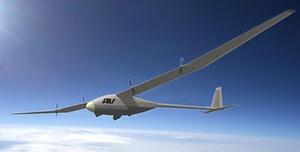Eyes in the skyHigh-altitude surveillance UAV completes maiden voyage
The first flight of a stratospheric unmanned aircraft — the Global Observer — designed to provide uninterrupted surveillance over any point on the globe was completed successfully; the company’s CEO says that in the 20th century, conventional airplanes opened the lower atmosphere to practical use and satellites did the same for space — “Global Observer soon will establish the stratosphere as a valuable and practical area of operation”

Global observer during testing // Source: blogspot.com
Monrovia, California-based AeroVironment (AV) has announced that the first flight has taken place of a stratospheric unmanned aircraft designed to provide uninterrupted surveillance over any point on the globe. On 5 August, Global Observer Aircraft 1001 took off from Edwards Air Force Base (EAFB) in California and climbed to an altitude of 4,000 ft, where it then performed maneuvers before landing an hour later. The aircraft was developed under the Global Observer Joint Capability Technology Demonstration program.
Graham Warwick writes in Aviation Week that AeroVironment’s chief test pilot, Andy Thurling operated the aircraft remotely from a portable Launch and Recovery Element (LRE), a piece of equipment that handles the take-off and landing functions of a UAV’s flight.
According to AeroVironment, Thurling guided the aircraft through a pre-determined flight path as the first step in a flight-test campaign that will gradually demonstrate increasing flight endurance and operating altitude.
The hybrid-electric aircraft flew for the first time under battery power and will ultimately carry a liquid hydrogen-fuelled propulsion system to power it through high altitude, long endurance joint operational utility assessment planned for later in 2010.
“In the 20th century, conventional airplanes opened the lower atmosphere to practical use and satellites did the same for space,” said Tim Conver, AV’s chairman and chief executive officer. “I believe that Global Observer soon will establish the stratosphere as a valuable and practical area of operation.”
Each aircraft in a Global Observer system is designed to fly at an altitude of between 55,000 and 65,000ft for five to seven days. In addition to flying above weather and above other conventional aircraft, operation in this altitude regime allows communications and sensor payloads on the aircraft to service an area on the surface of the earth up to 600 miles in diameter, which is equivalent to more than 280,000 square miles of coverage.
The joint test team is now preparing communications and intelligence, surveillance and reconnaissance payloads for aircraft integration. Once development flight tests are complete, payloads will be installed and joint operational utility flight demonstrations will be performed at EAFB.
